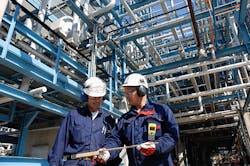Attorney Joseph P. Paranac Jr. Talks OSHA Changes: Stepped Up Inspections, Bigger Penalties
“Recent changes in OSHA rules and regulations will affect chemical companies and countless employers of all sizes,” veteran labor and employment attorney Joseph P. Paranac Jr. warned at the recent Metropolitan New York Coatings Association (MNYCA) Fall Technical Forum.
The changes facing chemical and other industries include a new proposed beryllium standard, rising penalty amounts, stepped-up rapid response investigations and new and more extensive hazcom (hazard communications) requirements. “Business should ensure they’re ready to meet these new challenges,” advised Paranac, a Newark, N.J.-based shareholder in national law firm LeClairRyan, who was a speaker at the event.
A new push from OSHA already hasresulted in a higher volume of complex chemical investigations, he noted.
“Previously, there was a perception that OSHA inspectors avoided time-consuming, complex inspections, because inspectors’ performance reviews were heavily weighted towards the number of cases they closed,” he explained. “But in September 2015, David Michaels, head of OSHA, revised the inspector review process and awarded Enforcement Unit points tied to the complexity of the inspection. This has encouraged inspectors to take on additional complex investigations. In response, companies may wish to conduct their own self-audits or retain a consultant to make sure their house is clean.”
Another development that affects a wide range of companies is a surge in new hazcom requirements, said Paranac. Following a phase-in of previously issued hazard communication standards, chemical manufacturers and other employers since June have been required to issue enhanced labeling for hazardous materials, and have had to enhance the way they train workers in handling hazardous material, he pointed out.
“The new standard also requires new material safety data sheet forms that must be made available to workers, informing them of the properties and hazards of certain substances. Employers can assume that there will be a big jump in OSHA hazcom inspections, so they should review the new standards to ensure they conform,” said Paranac, adding that perhaps one of the most contested issues is a proposed reduction in the currently permissible eight-hour exposure to beryllium, a widely-used material that can cause serious diseases.
“The current OSHA standard on beryllium was adopted in 1971,” he reported. “Under that standard, the OSHA eight-hour permissible exposure limit (PEL) is 2.0 micrograms per cubic meter of air. OSHA’s new proposed beryllium standard would reduce the eight-hour PEL to 0.2 micrograms per cubic meter.”
He noted the proposed new standard also would require personal protective equipment, medical exams and other medical surveillance and training. Industry pushback is likely to result in some changes to the proposed, he added, but some reduction in the allowable exposure is likely, so chemical companies in particular should track the rule and comply when it is finalized.
Chemical companies and others should also beware of the first increase in OSHA penalties in years, which went into effect on August 2 with hikes of about 80 percent, Paranac noted.
“Serious and other-than-serious posting requirement penalties rose from a maximum of $7,000 to $12,471 per violation,” he related. “Failure to abate maximums increased from $7,000 per day beyond abatement date to $12,471 per day, while the maximum penalty for willful or repeated violations jumped from $70,000 per violation to $124,709. The changes also give OSHA the authority to raise penalties to keep pace with inflation, so we may see more increases ahead.”
Other challenges include an increase in OSHA’s Rapid Response Investigation (RRI) requests – when OSHA contacts a reporting employer following an accident to learn more about the root cause and how to prevent similar incidents from occurring – which show no sign of abating.
“Further, an employer’s response to an RRI request can exacerbate the problem, especially if OSHA believes the employer is trying to whitewash the incident, perhaps by blaming the victim,” Paranac warned. “If OSHA is not satisfied with the employer’s RRI, it can mount its own inspection of the incident. Companies that want to minimize that possibility may consider contracting with outside consultants who offer OSHA and RRI seminars that focus on best reporting practices.”
These and other OSHA activities potentially could impact a wide range of companies. “The costs of non-compliance, or even being unprepared, may be significant,” concluded Paranac.
About the Author

Sandy Smith
Sandy Smith is the former content director of EHS Today, and is currently the EHSQ content & community lead at Intelex Technologies Inc. She has written about occupational safety and health and environmental issues since 1990.
